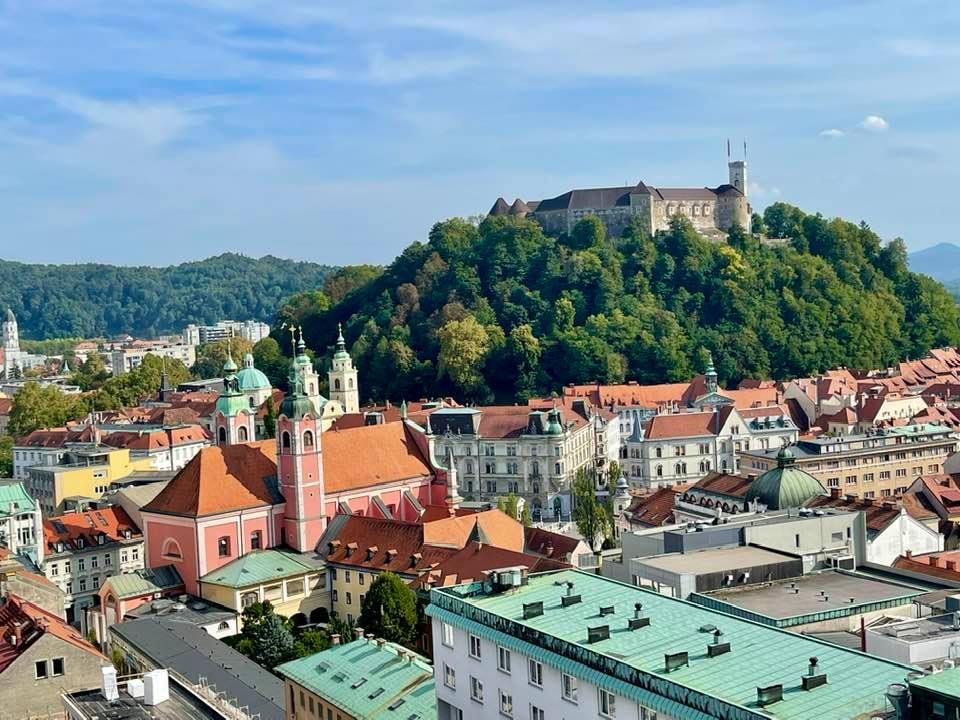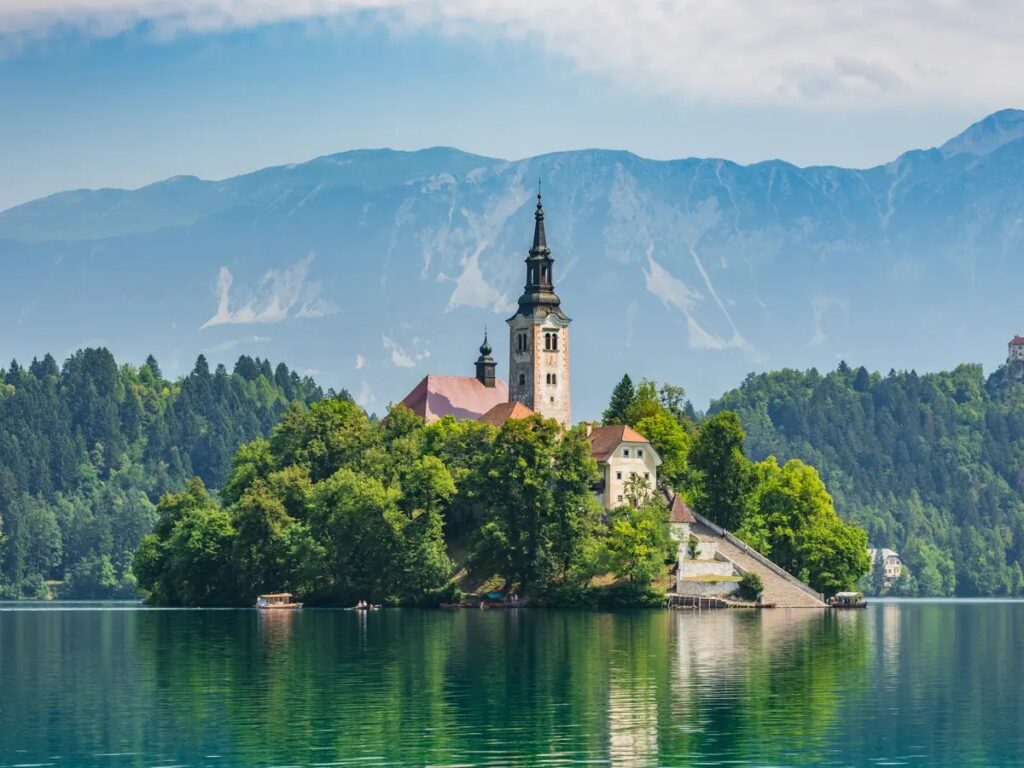
Kranj: A Town Making an Impact with Majestic Mountains, Enchanting Cave Dragons, and Sustainable Cuisine
Typically, the idea of listening to a beatbox rendition of the Beatles’ From Me to You performed live would make me cringe. However, the genuine manner in which Zigan Krajncan, a singer and dancer, revamps the song, employing high-pitched melodic trills and adding a booming bass by thumping his chest, captivates me, causing me to sway in a trance-like state.
Donning a slender frame and walking barefoot, his unkempt blond hair tied up, Krajnčan takes the stage alongside his cellist brother Kristijan at the intimate wooden theater-like venue known as Layer House, located in Kranj, northern Slovenia. Their performance spans across genres, ranging from beatbox to an orchestral pop reminiscent of Radiohead, making the theater a captivating platform for showcasing the abundant local talent
While the musical prowess on display is undoubtedly impressive, it is not the primary motive behind my visit to Kranj. Despite its modest population of merely 38,000 residents, Kranj holds the distinction of being Slovenia’s third-largest city. What drew me here is the fact that Kranj was designated as the Sustainable Tourism Pioneer for 2023 by the European Commission’s Destinations of Excellence program. This initiative focuses on promoting environmentally friendly tourism in smaller destinations, and Kranj stands as a shining example of their efforts
Kranj’s commitment to preserving its pristine rural ambiance, complemented by the majestic Karavankas mountains, has been duly recognized and rewarded. In 2016, Kranj made history as the inaugural Slovenian municipality to introduce a bike-sharing program, enabling users to conveniently travel between towns. The city’s venues have been lauded for their efforts in waste reduction and promoting local supply chains. Additionally, the Actum Hotel, along with 152 other establishments in Slovenia, has been granted the esteemed Green Key certification for its commitment to sustainable hospitality practices
In an effort to reduce emissions from school runs, children in Kranj are actively encouraged to monitor their carbon footprint, highlighting the city’s commitment to sustainability. Leading by example, the local government of Kranj achieved a significant milestone by transitioning their entire fleet of vehicles to fully electric, marking a pioneering step in Slovenia. The city’s ambition goes even further as it aspires to attain official “climate neutral” status, aligning with the EU’s mission of having 100 Climate Neutral and Smart Cities by 2030.
Nevertheless, Kranj’s appeal extends beyond its collection of sustainability accolades. I come to realize this when Aljaz Primozic adorns my head with a top hat and captures a photograph of me using a vintage glass photography camera in the captivating Inventor Puhar Cabinet, his museum situated in the revitalized old town of Kranj.
Nestled within a picturesque alley, amidst Renaissance townhouses topped with vibrant orange roofs, lies the Inventor Puhar Cabinet museum. This charming museum is dedicated to honoring the achievements of Slovenian inventor Janez Puhar, who resided in Kranj and revolutionized the world of photography in 1842 with his groundbreaking technique of capturing images on glass plates. Alongside Puhar’s glass self-portrait photo, the museum showcases an eclectic array of artifacts collected from flea markets and discarded items, including a captivating assortment of potion bottles, paintings, and pump organs. The outdoor walls surrounding the museum proudly feature thought-provoking artworks by The Miha Artnak, an artist and environmental activist, depicting the issue of plastic waste.
Taking center stage within the museum is Puhar’s glass self-portrait, a testament to his ingenuity. Aljaz Primozic, the curator, proudly remarks, “While the internet claims that the first selfie was taken by an American gentleman in 1839, this right here is the first Slovenian selfie
Embodying a similar philosophy, PR Končovc, a family-owned restaurant perched on a hillside in Javornik village, is helmed by Katarina and Aleš Kristan, who prioritize using ingredients sourced from their very own farm. The results of their dedication are truly exceptional, evident in dishes like the delectable wild garlic soup and pear-filled štruklji, a beloved doughy dessert of Slovenia. Similar to Actum Hotel, PR Končovc proudly boasts a Green Key certification, which Katarina mentions required changes such as switching to eco-friendly laundry detergent. She remarks, “Being an example for other restaurants feels rewarding.
Kranj garners approximately 60,000 visitors annually, with city officials emphasizing their intention to avoid the overwhelming crowds often seen in nearby Bled. They recognize that despite Kranj’s significant industrial presence, with companies like Goodyear operating factories in the area, fostering more sustainable tourism is just one aspect of the city’s environmental impact

Strolling along the Kokra River trail that winds through the city center, the fresh air serves as a testament to the positive changes reflected in Kranj’s growing collection of sustainability accolades. A tourism official acknowledges that there is still much work to be done, highlighting the next challenge of persuading restaurants to install electric vehicle chargers. Departing from Kranj, I feel content, not only because I possess a glass photograph of myself donning an enormous top hat, but also due to the satisfaction of experiencing the city’s progressive strides
While the presence of these intriguing little cave dragons adds to the appeal, it is the serene rural setting of Kranj that truly makes it a destination worth exploring. Positioned as an “in-between” place, Kranj lies approximately 18 miles away from both the capital city of Ljubljana and the renowned Lake Bled, lending it a unique position on the map. However, it is the captivating countryside surrounding Kranj that truly captivates me, as the eastern shores of the lake are already brimming with numerous hotels and accommodations, diminishing some of its allure.
Embarking on a scenic journey along winding mountain roads, I make my way approximately 11 miles west to the enchanting Church of St Primus and Felicianus in Jamnik. Nestled at the edge of a sparsely populated stretch of rugged mountains, this solitary church has gained popularity as an Instagram hotspot during the summer months. However, on this occasion, with a light April rain falling, I find myself enjoying the tranquil ridge all to myself, savoring the solitude and serenity.
These charming villages are also home to a selection of sustainable restaurants. One such establishment is Gostilna Kristof in Predoslje, where I indulge in a remarkable dining experience featuring seven thoughtfully crafted courses, primarily sourced from local Slovenian ingredients. While the restaurant maintains a high-end culinary experience, its warm and welcoming atmosphere evokes a sense of homeliness. With a four-course menu priced at €50, Gostilna Kristof offers a remarkable balance of quality and value.



